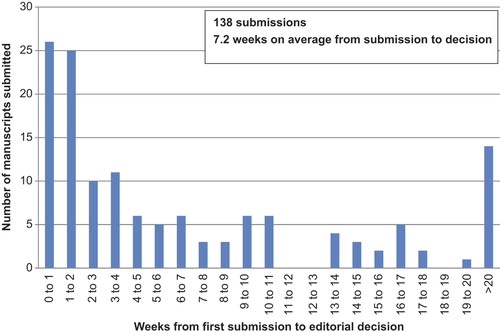Every now and then, as a national editor, I receive complaints about the manuscript processing from submission to acceptance or rejection being far too slow in the Scandinavian Journal of Primary Health Care (). On a few occasions, we as editors are to blame for that. On other occasions, reviewers and the reviewing process slow down progression towards publication. However, occasionally the authors could have helped speed up the process.
Figure 1. Number of original articles submitted in 2013 and time from first submission to editorial decision to accept, reject, or encourage resubmission after revision.

Editors and authors have a mutual interest in keeping processing time within reasonable limits. Shortly after the submitted paper is received by the editorial office, the Editor-in-Chief designates one of the national editors to make the first assessment of the manuscript. If criteria are met with respect to relevance for the Journal's readers, scientific contribution, general quality, adherence to Journal guidelines, and clear and understandable English, two or more reviewers are selected from the Journal's database of reviewers or elsewhere. Attempts are made to match reviewers with subject matter and methodology as far as possible. Usually, a period of two weeks is given for reviewers to accept or decline reviewing. If accepting, four further weeks are allowed for reviewers to provide a thorough evaluation of the manuscript. Based on the reviewers’ comments, the national editor decides whether to accept, to suggest amendments, or to reject the manuscript. Very seldom is a manuscript accepted without any changes. This first evaluation of the manuscript should be completed within 12 to 14 weeks, which actually is the case for 80% of manuscripts submitted to the Scandinavian Journal of Primary Health Care (see ).
When amendments are suggested, the manuscript is most often formally rejected, but the authors are encouraged to resubmit, addressing the changes required.
Experiencing rejection of your manuscript should not make you panic! Calm down and read the reviewers’ and editor's comments carefully. Consider the comments and reflect on whether it is most sensible to submit to another journal or, if invited, to resubmit. Suggestions to make revisions should be addressed systematically point by point. Do everything required, unless there are good reasons not to. The reasons not to follow suggestions should be very explicitly explained. Be gracious and respectful in your resubmission letter.
When resubmitted, the manuscript is again scrutinized, most often by the original reviewers, but on occasions by the editorial board alone. The final decision whether to publish or not is made by the Editor-in-Chief. Appeal is possible, but seldom advisable.
What can authors do to facilitate the process?
Submitted manuscripts should be specifically aimed at the Scandinavian Journal of Primary Health Care. Make sure you comply meticulously with author guidelines in format, style, and length as well as number of tables, figures, and references (http://informahealthcare.com/page/pri/Description#Instructions) and have your manuscript proofread. Use proper English, observing grammatical and expression conventions.
When to approach the editorial office about progress
If you have not received a decision from the Editor-in-Chief within, say, four to six months after submission, it may be appropriate to e-mail the editorial office and respectfully enquire about the progress. The editors acknowledge the fact that getting published in most instances is career-enhancing and that any delays may cost you and at the least be annoying. However, you should remember that the editors of the Scandinavian Journal of Primary Health Care, as well as the reviewers, are unpaid volunteers, so please be patient.
What can reviewers do to facilitate the process?
Peer review is employed to maintain standards of quality, improve performance, and provide credibility in determining an academic manuscript's suitability for publication. Any scientist wishing to publish should every now and then also volunteer to review manuscripts.
Unfortunately, quite a few potential reviewers do not accept to review when asked. It is not uncommon to have to invite eight to 10 reviewers just to find two who will accept, i.e. only 25% accept. Please consider carefully when asked to review. It is acknowledged that time is a limited resource and time for reviewing may be hard to find in a tight schedule. However, even the busiest scientist should be able to respond to a request to review within a few days. If accepting, deadlines should be kept to help both editors and authors. As long as we know no better way to achieve quality control, albeit with shortcomings [Citation1], we all have an obligation to help the peer review process to run as fairly and smoothly as possible. We must remember that today's authors may be tomorrow's reviewers and vice versa.
Conclusions
Speeding up the review process to reduce time from submission to publication is a mutual responsibility of editors, reviewers, and authors. As editors we try to handle incoming manuscripts expeditiously and most often I think we succeed. As members of the scientific community we should all say: “Yes, I will”, when asked to review. If it cannot be done in a reasonable amount of time, say no immediately. Never let invitations to review stay in your inbox. If declining, it is helpful to suggest colleagues who might be good alternatives. Do not consider the deadline a suggested time to start reviewing.
Authors should be aware that the Journal's guidelines are not kind suggestions but mandatory requirements.
Reference
- Bohannon J. Who's afraid of peer review? Science 2013;342:60–5.
